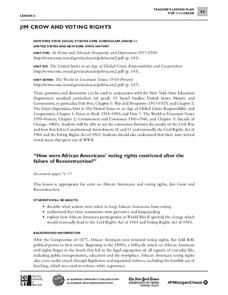Curated OER
Martin Luther King and Malcom X on Violence and Integration
Dr. Martin Luther King and Malcolm X were contemporaries. Both were gifted orators, both were preachers, both were leaders during the Civil Rights era, both were assassinated. But the two had very different views on violence and...
Teacher Created Resources
Angelina and Sarah Grimke: Sisters of Social Reform
Who are the Grimke sisters? Scholars find out with a worksheet that details the struggles and triumphs of the lives of Angelina and Sarah Grimke. After reading an informational text, class members have the opportunity to show what they...
Curated OER
Prudence Crandall House and Little Rock High School
Students examine how Prudence Crandall influenced the education of African Americans in New England prior to the Civil War and compare and contrast events in Canterbury, CN in the 1830's to those in Little Rock, AR in the 1950's.
Curated OER
Langston Hughes: Dream Variations
Students examine African-American communal life. In this Langston Hughes lesson, students read poetry by Hughes in order to gain insight into the Harlem community. Students select artwork that represents their community.
Curated OER
Barack Obama
In this black history learning exercise, students read a short, informational passage about Barack Obama. Students then answer 8 questions about the text.
Curated OER
Slave Resistance
Students examine slavery and slave resistance. In this history instructional activity, students read several excerpts on slavery then work in small groups to reflect and answer questions on the readings.
Curated OER
Being Me in the Face of Adversity - Americans Who Stood Up for Their Beliefs
Students identify important Americans from the colonial, revolutionary and slavery periods who are noted for standing up for their beliefs in the face of peer disapproval. They identify the importance of music in motivating and...
Curated OER
Past Presence
Learners examine British Black History. In this current events lesson, students visit selected websites to research the history of Blacks in Great Britain. Several lesson enhancement ideas are included.
Curated OER
Ella Fitzgerald: Something to Live For
Students examine the basic characteristics of jazz, and its relationship to African-American culture and history. They listen to examples of jazz, conduct research, and create a 20th century timeline of music and historical events.
Curated OER
Inside The Harlem Renaissance
Students explore the Harlem Renaissance to discover where, when, and why it took place and who was associated with the experience. They decide what are the most informative facts, interesting people, and events in this lesson.
Curated OER
Black Separatism or the Beloved Community? Malcolm X and Martin Luther King, Jr.
High schoolers interpret historical evidence presented in primary and secondary resources. For this African American history lesson, students compare and contrast the tactics employed by Malcolm X and Martin...
Curated OER
How Africans Became Slaves for the Colonists
Students complete a t-chart identifying the advantages and disadvantages of having indentured servants. In groups, they research the use of serfs and slaves in various cultures and share their responses. To end the lesson plan, they...
Curated OER
American Music Styles: European Roots and African Influences - Lesson 3
Students describe some of the characteristics of country and blues music. They see how country music rose to a nationally known music style. They write a two-paragraph essay on what they think country music be like in the next 100 years.
Curated OER
Habari Gani: What is the News?
Display creative works of art after learning about Kwanzaa. Kindergartners hear stories about the history of Kwanzaa and its celebrations. They then create artwork, practice African dances and listen to African music.
Curated OER
Muhammad Ali
Young scholars analyze the lifetime accomplishments of Muhammad Ali in the area of sports and his role as a catalyst for social change.
Center for History Education
Daily Lives of Slaves - What Really Happened?
The stories of enslaved people are preserved forever thanks to the Great Depression. Budding historians explore slave narratives gathered by a federal government initiative to discover what life was actually like for enslaved people....
Curated OER
The Homefront: America and WWII
Students are introduced to the experiences of various groups of Americans at home during WWII, highlighting race, gender, and ethnicity. They improve their ability to analyze and interpret historical documents and images.
Curated OER
Pop Culture and Art
Learn about American pop culture, art, and the social voice that art can convey. The class discusses the life and art of Barton Benes, views his piece Reliquarium, then discusses what they see and feel when they view his work. Make sure...
Curated OER
A Comparative Look at Migrations
Students explore and compare and contrast the migrations of African Americans in the United States in the decades before and after the Civil War.
Curated OER
Priorities and Power: Migrants and Voting
Students examine the African-American migrants entry into the political process. They summarize their findings in a short essay.
Curated OER
American Veterans: Past and Present
Research groups present an audio report on modern veteran issues in a radio show format.
National Woman's History Museum
Stacey Abrams: Changing the Trajectory of Protecting People’s Voices and Votes
In this project-based learning lesson, young social scientists investigate Stacey Abrams' campaign to protect the voting rights of people across the nation. Investigators learn how to annotate assigned articles, watch videos, and collect...
C3 Teachers
Black Women Writers: What Gets Black Women Heard?
Zora Neal Hurston, Toni Morrison, and Maya Angelou are featured in a guided inquiry unit. High schoolers research the lives and works of these and other Black women writers and craft an argument, using evidence from their research, to...
City University of New York
Jim Crow and Voting Rights
Class groups examine primary source documents to determine how the voting rights of African Americans were restricted after the failure of Reconstruction, and how African American participation in World War II lead to change.

























